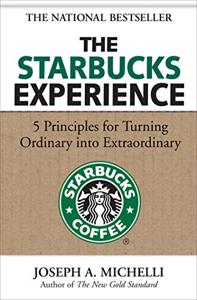
Want to learn the ideas in The Starbucks Experience better than ever? Read the world’s #1 book summary of The Starbucks Experience by Joseph Michelli here.
Read a brief 1-Page Summary or watch video summaries curated by our expert team. Note: this book guide is not affiliated with or endorsed by the publisher or author, and we always encourage you to purchase and read the full book.
Video Summaries of The Starbucks Experience
We’ve scoured the Internet for the very best videos on The Starbucks Experience, from high-quality videos summaries to interviews or commentary by Joseph Michelli.
1-Page Summary of The Starbucks Experience
More than Free Refills
Starbucks Coffee, Tea and Spice opened in 1971. It was different from other coffee shops because it offered customers high-quality beans, careful preparation of drinks, nice stores and good design. Since then the company has grown to have 11000 stores in 37 countries with 35 million customers visiting Starbucks weekly. Today they buy about 4% of all the coffee sold worldwide.
Starbucks went public in 1992 and is now worth $650,000 if you invested $10,000 then. It opens a new store somewhere in the world every day of the year and has 500 stores in Japan including the busiest Starbucks in the world. In some places it has opened stores across from one another.
Starbucks has been a successful company because it focuses on its employees, products, customers’ experience and relationship with the community.
The Starbucks Experience
Starbucks has become a top global brand by adhering to five key principles. First, customize the experience for your customers. Second, focus on every aspect of the job and never lose sight of what’s important: your customer’s point of view. Third, do unexpected things to keep people coming back (surprise and delight). Fourth, learn from mistakes; don’t be afraid to make them. Fifth and finally, leave a lasting impression with your work so that people remember you long after they’ve left the store.
The Partner Ethos
Starbucks’ success is largely due to two of its corporate values:
Employees are partners, and they’re encouraged to contribute ideas for improving the company. They also help develop new products, which is a huge part of Starbucks’ success.
Starbucks executives believe in profit sharing. Employees receive company stock and medical insurance because of their belief that employees should be rewarded for the profits they help generate. The chain also gives bonuses to hourly workers who perform well above expectations.
Starbucks spends the most money on employee training and has one of the lowest turnover rates in its industry. They also have a high job satisfaction rate compared to other fast-food chains, which is likely due to their extensive worker training program.
Starbucks pays great attention to their employees and makes important changes quickly. When an employee group wanted to extend paid parental leave for adoption, it was changed within 2 weeks.
Principle One: “Make It Your Own”
Starbucks founder Howard Schultz has said that he is not in the coffee business but rather a people business. He believes it’s important to connect with customers and their communities. In order to do this, Starbucks teaches its employees five principles: 1) Be welcoming; 2) Engage in conversation; 3) Listen actively; 4) Anticipate needs; 5) Be empathetic.
“Be genuine” – Partners must be active listeners and good observers. Noticing that a new customer looked as though she was about to cry, a barista offered her a toffee nut latte. She thanked the barista for his kindness by sending him flowers.
In the business world, it’s important to be considerate of others and the environment. For example, we can reduce carbon dioxide emissions by using wind energy and planting trees in communities.
Nespresso partners are trained in coffee. They learn about tasting, handling and service through internal publications and classes. It ensures that they use the product they sell as well as motivating them to share their passion for coffee with others! Additionally, some Nespresso partners become “Coffee Masters” by enlisting in a three-month program consisting of lectures and exercises.





